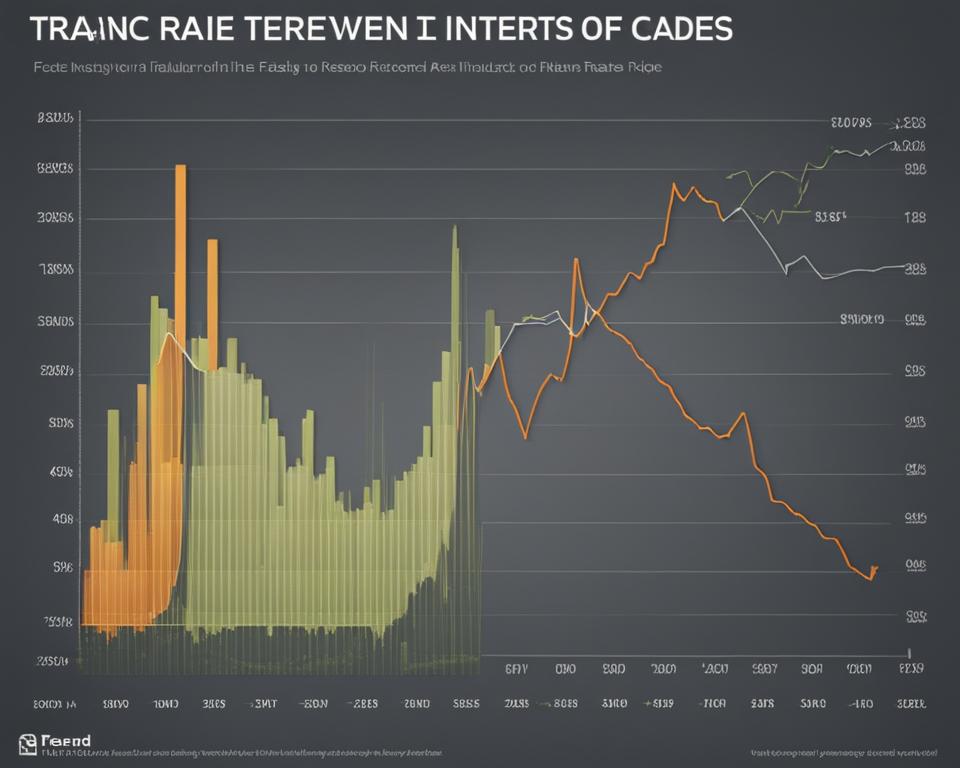As the economic landscape continues to present challenges and opportunities, individuals and investors are keenly watching interest rate trends to make informed financial decisions. In the current climate, interest rates have become a pivotal indicator of economic health, influencing the cost of borrowing and the yield on savings across the board. With the Federal Reserve interest rates taking center stage, the increase to roughly 5.25 to 5.5% has marked a significant shift, reminiscent of interest dynamics not seen since the 1970s.
Whether someone is looking to lock in low interest rates for a mortgage or seeking the best interest rates for their savings accounts, it’s essential to remain vigilant. Fluctuations can happen swiftly, as seen in the recent volatility of current interest rates. An interest rate calculator can be an invaluable tool amidst these fluctuations, aiding in the navigation of interest rate trends and fostering better financial planning. For homeowners or those in the market, understanding mortgage rates in relation to interest rate fluctuations becomes crucial in securing favorable terms.
Ultimately, keeping a careful eye on these movements helps individuals and businesses alike to strategize effectively, whether it’s for obtaining credit, investing, or saving. Despite the complexities of the economic environment, one can find avenues to adapt and thrive—even in times of uncertainty.
Key Takeaways
- Interest rate trends are critical for financial decision-making in today’s economy.
- The Federal Reserve has increased rates to a level not seen since the early 2000s.
- An interest rate calculator is an essential tool for planning finances amid rate changes.
- Mortgage rates are intimately tied to broader interest rate fluctuations.
- Careful monitoring of current interest rates is vital for both personal and business financial health.
- Despite rising interest rates, there are strategies to secure low rates and maximize savings.
Understanding the Recent Rollercoaster of Global Interest Rates
In an environment characterized by unpredictability, global interest rates have been on a wild ride, impacting financial markets from the advanced economies to the furthest reaches of the investment world. The 10-year US Treasuries, often considered a benchmark for other interest rates, have become a focal point for both investors and policymakers trying to gauge the trajectory of the economy.
The Rise and Dip of US Treasury Yields
The yields on the 10-year US Treasuries have seen dramatic fluctuations, reaching milestone highs before tempering down—a pattern akin to a financial rollercoaster. Such significant interest rate moves have not only made headlines but have also led to a surge of scrutiny and analysis from across the investment community.
Comparative Interest Rate Movements in Advanced Economies
It’s not just the United States experiencing these dramatic shifts; other advanced economies have been part of this phenomenon as well. This global symphony of rate adjustments can leave even the most seasoned financial experts in search of answers.
| Country | Peak Interest Rate | Current Interest Rate | Yearly Change |
|---|---|---|---|
| United States | 5.00% | 4.75% | -0.25% |
| Germany | 0.50% | 0.25% | -0.25% |
| Japan | 0.25% | 0.10% | -0.15% |
| United Kingdom | 2.50% | 2.25% | -0.25% |
Emerging Markets and Their Diminished Sensitivity to US Interest Rates
The evolving dynamics of the global economy are reflected through the changing relationship between emerging markets and the influence of US interest rates. Quite notably, the economic literature indicates a substantial shift in how these markets respond to the monetary policy tightening measures administered by the US Federal Reserve. The resulting scenario is a testament to the resilience and strategic adaptation of emerging market economies in the face of international monetary fluctuations.
Tightening Monetary Policies and Their Impact on Emerging Markets
In recent times, emerging markets have demonstrated a remarkable fortitude against the variances of US interest rates. Traditionally, movements in US monetary policies would apply considerable pressure on these markets. However, thanks to comprehensive initiatives in monetary policy tightening and effective economic planning, they have reached a level of insulation from these pressures that was unprecedented in the past. The International Monetary Fund has played a pivotal role in guiding these markets towards policies that promote sustainability and reduced vulnerability to the spillovers from advanced economies.
Historical Spillovers Versus Current Trends
Contrasting with the historical spillovers that caused ripples across emerging markets due to oscillations in US interest rates, current trends suggest a decoupling effect. Empirical studies, a crucial part of economic literature, have started showcasing emerging markets as more self-reliant, buffered against global interest rate shocks by their internal policy reforms and burgeoning economic structures. This recalibration of their sensitivity is reshaping traditional financial narratives and forging new pathways for international economic integration.
Interest Rates and Resilience Measures in Major Emerging Markets
Stability in the face of external pressures is crucial for emerging economies, and major markets have risen to the challenge. Through a series of strategic policy framework reforms, these nations have fortified their standing against the unpredictability of the global financial landscape, hence bolstering emerging market resilience.

Policy Framework Reforms and Their Benefits
Central to these advancements is the elevation of central bank autonomy and the reinforcement of fiscal governance. Mainstreaming an agile exchange rate mechanism has allowed for a fluid response to fluctuating currency valuations, while meticulous management of public debt underscores a commitment to fiscal prudence.
- Enhanced central bank independence
- Improved monetary and fiscal policy frameworks
- Increased exchange rate flexibility
- Strengthened public debt management
This proactive stance nurtures an economic climate that exudes confidence to foreign investors, even amidst global financial tensions.
The Role of Foreign Investor Activity During Volatility
The perseverance of foreign investment testifies to the efficacy of these reforms. Rather than retreating at signs of disturbance, investors have maintained, and in some instances escalated, their stake in these vibrant markets. Such enduring interest underscores the trust investors place in these reforms—trust that these markets can withstand and navigate through external pressures with poise.
Despite ongoing global economic challenges, the strategic reforms adopted by emerging markets have successfully stabilized foreign investor engagement, underscoring an improved risk profile and resilience of these economies.
Prospective Economic Challenges and Interest Rate Differentials
As we steer through an era characterized by economic uncertainties and fiscal adjustments, economic challenges continue to morph and evolve. This section delves into the anticipated shifts in interest rate differentials that hold potential repercussions for global capital flows, especially in the context of emerging markets. With countries bracing for the impact of quantitative tightening, these dynamics are critical pointers to future policy directions and economic strategies.
Quantitative Tightening and Emerging Market Capital Flows
The economic landscape is observing a tightening scenario, where major central banks have embarked on quantitative tightening to normalize policy post the unprecedented liquidity infusions. This trajectory poses risks to developing economies as it may lead to significant shifts in capital flows. Emerging markets, historically reliant on the inbound liquidity provided by loose monetary policies in advanced economies, must now navigate through the complexities introduced by this paradigm shift. An adverse side effect could be the exacerbation of current account deficits, prompting a renewed evaluation of domestic fiscal policies.
Global Volatility and Interest Rate Projections
The global financial system finds itself on the cusp of potentially turbulent times, where interest rate differentials become a compass for navigating volatility. These differentials, crucial for investors seeking optimal asset allocation, are expected to narrow, affecting not just investments but also currency value and exchange rates. As global volatility escalates, fuelled by unforeseeable economic data releases and geopolitical tremors, the imperative for shrewd interest rate projections becomes more profound. These projections influence everything from international trade agreements to individual investment decisions, making them a cornerstone of fiscal prudence in an interlinked global economy.
Monitoring these movements is not just about vigilance but also involves proactive strategies to mitigate potential aftershocks. Such an approach includes the resilience-building measures adopted by emerging markets, aimed at insulating their economies against global shockwaves. Preparing for these anticipatory changes ensures that nations and their financial systems are not caught off-guard by the inevitable fluctuations of a capricious global market.
Impact of Interest Rate Changes on Banks and Borrowers
The landscape of the finance world has markedly shifted due to significant interest rate changes. For both banks and borrowers, the ripple effect of a tighter monetary policy sets a complex stage where asset-liability management becomes not just significant, but essential. Banks are prompted to reassess their strategies, keeping a close eye on ever-evolving market demands, while borrowers face new challenges and opportunities amidst this tightening.
Monetary Policy Tightening: A Game Changer for Banks
In response to the elevated interest rate environment, banks are retooling their balance sheet management. With monetary policy tightening dictating the tempo, what we are witnessing is a renewed diligence on the part of financial institutions. They are re-evaluating risk management frameworks to combat potential volatility and are emphasizing the need for sophisticated analytical mechanisms to predict and mitigate the effects of interest rate changes.
Asset-Liability Management in a High-Rate Environment
The need for effective asset-liability management has never been more crucial. The current financial terrain, marked by aggressive policy adjustments and high inflation, necessitates a meticulous approach to bank operations. With the cost of borrowing climbing, banks must make informed decisions on how to align their asset and liability mix without compromising stability or customer trust.
| Key Focus Area | Impact of Interest Rate Rise | Response Strategy |
|---|---|---|
| Loan Pricing | Rising rates lead to more expensive loans | Dynamic pricing strategies to manage borrower demand |
| Deposit Rates | Pressure to increase rates offered on deposits | Tiered interest rates to attract and retain customers |
| Mortgages and Credit | Higher mortgage rates may dampen housing market | Flexible loan products and terms to aid borrowers |
| Investment Returns | Enhanced yields on interest-earning assets | Strategic rebalancing of investment portfolio |
Overall, as banks recalibrate in response to monetary policy tightening, they will need to communicate openly with borrowers, who on their end must become savvy about how changes in interest rates could affect their existing and future financial obligations. The harmony between banks and borrowers through this high-rate epoch is pivotal, grounded in transparency and a robust understanding of asset-liability management strategies.
Interest Rates and Inflation: The Causal Nexus
The interplay between interest rates and inflation is a fundamental aspect of economic policy. Recent movements in the Consumer Price Index have brought this relationship into sharp relief, with inflation reaching levels that urge a responsive adjustment in interest rates. The Federal Reserve, tasked with maintaining economic stability, has been compelled to make decisive moves. Below we explore the complements and contradictions that delineate the rate-inflation nexus.

As interest rates rise, the guiding rationale becomes apparent: to temper inflation by discouraging excessive borrowing and spending. While economic theories support the effectiveness of higher rates in cooling an overheated market, recent patterns suggest a more complex narrative. The resilience of the economy, even as the Federal Reserve imposes restrictive economic policies, points to a dynamic interplay that challenges traditional expectations.
| Year | Interest Rate (%) | Inflation Rate (%) | Consumer Price Index (CPI) |
|---|---|---|---|
| 2022 Q1 | 0.25 | 1.7 | 260.474 |
| 2022 Q2 | 0.50 | 5.4 | 270.981 |
| 2022 Q3 | 0.75 | 7.0 | 280.500 |
| 2022 Q4 | 1.00 | 6.5 | 276.589 |
The table above illustrates the recent correlation between rising Federal Reserve interest rates and the accompanying trend in inflation, using the Consumer Price Index as an indicator. The quarter-by-quarter representation underscores not just the rising trajectory of rates, but also the uneven pace at which inflation responds to these economic levers. These figures catalyze a broader discussion on the strategic efficacy of interest rate adjustments in the current economy.
Despite the Federal Reserve’s aggressive stance on interest rates, the anticipated dampening effect on inflation has been met with an unexpectedly robust economic resilience—a testament to the complexities of modern economic systems.
Mortgage Rates in the Context of Current Interest Rates
As the financial landscape grapples with rising current interest rates, homebuyers are met with the challenge of securing the best mortgage rates possible. Understanding the interplay between mortgage rates and the broader economy becomes crucial in this pursuit. With the right knowledge and strategies, homebuyers can position themselves favorably to lock in low mortgage rates, despite the trend towards higher interest costs.
Identifying the Best Mortgage Rates amidst Rising Interest
Finding the best mortgage rates today is akin to navigating a rapidly changing maze. The rates a homebuyer secures now can significantly impact their financial health over the life of a mortgage. Therefore, it is essential for prospective buyers to monitor mortgage rate trends and compare offers from various lenders to identify the most advantageous deal.
Locking in Low Mortgage Rates: Strategies for Homebuyers
To effectively lock in low mortgage rates, homebuyers should consider several key strategies. These tactics range from improving credit scores and managing debt-to-income ratios, to exploring various mortgage types and terms. Timing also plays a critical role. Staying attuned to economic indicators can help predict when to commit to a rate, securing a stable financial future amid fluctuating interest rates.
| Mortgage Type | Rate (APR) | Monthly Payment* | Total Interest Paid |
|---|---|---|---|
| 30-Year Fixed | 3.5% | $1,347 | $184,968 |
| 20-Year Fixed | 3.0% | $1,659 | $98,223 |
| 15-Year Fixed | 2.5% | $1,997 | $59,431 |
| 5/1 ARM | 2.75% | $1,224 | $50,097 |
*Note: Monthly payments are approximate and based on a $250,000 mortgage with a 20% down payment. Total interest paid reflects the lifetime cost, assuming rates remain constant over the term and payments are made as scheduled.
In summary, even as current interest rates ascend, educated homebuyers can still advantageously navigate the mortgage market. By leveraging the strategies above and vigilantly watching the rate environment, obtaining a favorable mortgage rate remains within reach.
Maximizing Savings with High-Yield Accounts in a High Interest Rate Era
In times of high interest rates, savvy savers may find that traditional savings accounts don’t offer the financial growth they’re looking for. Instead, turning to high-yield accounts has become a strategic move for those aiming to enhance their savings. With the potential for much higher annual percentage yields (APYs), these accounts are instrumental in maximizing savings during periods when high interest rates prevail.
Financial institutions such as UFB Direct and Varo are at the forefront, offering noteworthy APYs that can exceed 5%. These high-yield accounts come with additional perks that benefit the account holder, such as no monthly fees and low minimum balance requirements. Below is a comparison of some leading high-yield savings accounts illustrating their competitive features that aid in bolstering your savings potential.
| Bank | High-Yield Account Type | APY | Monthly Fees | Minimum Balance |
|---|---|---|---|---|
| UFB Direct | High-Yield Savings | 5.02% | None | $0 |
| Varo | Varo Savings Account | 5.00% | None | $0 |
Opting for accounts like these can significantly increase the return on your stored capital compared to traditional savings accounts which often have much lower interest rates. It’s evident that these high-yield accounts can serve as a powerful tool for individuals looking to capitalize on the current high-rate environment, turning a regular act of saving into a more lucrative financial venture.
The Federal Reserve Interest Rates and Their Wider Implications
As the custodian of monetary policy, the Federal Reserve’s adjustments to interest rates are pivotal in directing the nation’s economic climate. The delicate balance of mitigating inflation while fostering economic growth is at the core of the Fed’s mission, influencing both macroeconomic conditions and individual financial planning. Understanding how these rate adjustments impact the broader economy and personal finance is essential for navigating an increasingly complex financial landscape.
Federal Reserve’s Response to Inflation and Economic Growth
The Federal Reserve has a dual mandate: to maintain price stability and to maximize sustainable employment. In response to rising inflation, rate hikes are often implemented as a braking mechanism. By increasing the cost of borrowing, the Fed aims to cool down consumer spending and business investment, which in turn can help to bring inflation back into acceptable ranges. However, these decisions must be weighed against the potential for hindering economic growth, making financial planning a strategic imperative for businesses and individuals alike.
Navigating Federal Reserve Interest Rate Hikes
In times of rate hikes, it is crucial for individuals and organizations to reassess their financial plans. Strategies such as refinancing debt, optimizing investment portfolios, and ensuring emergency savings become more critical. These measures help cushion against the volatility and uncertainty that often accompany changes in Federal Reserve interest rates.
| Financial Indicator | Pre-Hike | Post-Hike | Long-Term Considerations |
|---|---|---|---|
| Savings Account Yields | Lower Interest | Higher Interest | Shift to high-yield accounts |
| Loan Interest Rates | More affordable borrowing | Increased borrowing costs | Consider debt consolidation or refinancing |
| Investment Portfolio | Growth-focused | Risk-adjusted returns | Balance between equities and fixed income |
The table above exhibits the direct effects that Federal Reserve interest rate adjustments can have on various financial indicators, underlining the importance of proactive financial planning during different phases of the economic cycle. Reading the signals correctly and responding with agility can safeguard assets and even present new opportunities for growth amidst inflation and rate changes.
Interest Rate Fluctuations and Their Influence on Investments
As the economic landscape continues to evolve, interest rate fluctuations remain a pivotal factor influencing investment decisions. For both seasoned and novice investors, understanding and adapting to these changes is paramount for capital preservation and growth. The right investment strategies can help navigate through volatile interest rate trends, while risk management practices ensure that portfolios are positioned to handle the unpredictability of the market.
Adapting Investment Strategies to Interest Rate Trends
Investors must remain agile, realigning their portfolios in response to the current interest rate environment. A trend towards rising interest rates, for instance, may prompt a shift towards fixed-income assets that can benefit from higher yields. Meanwhile, an outlook on declining rates could pivot the emphasis towards growth stocks, which typically flourish in a low-cost borrowing environment. By staying attuned to the Federal Reserve’s monetary policy signals and economic forecasts, investors can make calculated adjustments to their investment allocations.
Risk Management in an Unstable Interest Rate Climate
Risk management takes on added significance when contending with unstable interest rates. A diversified investment portfolio can mitigate the risks associated with any one asset class being adversely affected by interest rate movements. Additionally, employing derivative strategies like options can provide a hedge against interest rate risks. It’s crucial that investors regularly reassess their risk tolerance and adjust their portfolios accordingly to withstand the ebb and flow of changing rates without compromising their investment objectives.
Ultimately, the key to successfully navigating the treacherous waters of interest rate fluctuations lies in continuous education, vigilant monitoring of interest rate trends, and the application of dynamic investment strategies and rigorous risk management tactics.
Using an Interest Rate Calculator to Forecast Financial Outcomes
As the financial landscapes continue to shift, the use of an interest rate calculator has become an invaluable asset for those committed to effective financial planning. These calculators provide much-needed clarity amidst the complexities of rate fluctuations, empowering users to make strategic decisions based on rate predictions and anticipated market movements.
With an eye toward the future, individuals and financial professionals alike utilize these tools to forecast financial outcomes. Whether calculating the long-term implications on a mortgage, determining potential savings account growth, or estimating the impact on investment portfolios, the accuracy provided by these calculators is essential.
“By applying current and projected interest rates into our financial models, we’re able to forecast with greater precision and prepare for various financial scenarios.”
- Monthly Mortgage Payment Estimates
- Savings Account Growth Forecasts
- Investment Return Projections
In the table below, see how different interest rate scenarios can affect a hypothetical investment over a five-year period, highlighting the necessity for dynamic financial planning and forecasting.
| Year | Starting Balance | Interest Rate | End of Year Balance |
|---|---|---|---|
| 1 | $10,000 | 3% | $10,300 |
| 2 | $10,300 | 3.5% | $10,660.50 |
| 3 | $10,660.50 | 4% | $11,086.92 |
| 4 | $11,086.92 | 4.5% | $11,585.93 |
| 5 | $11,585.93 | 5% | $12,165.23 |
This example helps underscore the advantage of utilizing an interest rate calculator to forecast financial outcomes, particularly in how slight changes in interest can greatly influence the ending balance of an investment. In the landscape of personal finance, these predictive tools are central to designing a robust financial plan capable of adapting to the ever-variable nature of interest rates.
Interest Rate Trends and Forecasting Future Rate Movements
Delving into the patterns of interest rate trends and their implications is an integral part of understanding economic health. Experts rely heavily on both historical analysis and current economic indicators to make educated predictions about the direction in which rates are heading. Accurate forecasting of rates is more than statistical guesswork; it involves a deep comprehension of how past trends can signal forthcoming changes.
Historical Analysis of Interest Rates
Analyzing decades of interest rate data can yield insights into cyclical patterns and the response of markets during various economic phases. Through a historical lens, one can identify periods of economic boom and recession, which are often closely aligned with the fluctuation of interest rates. This long-term view not only serves to understand past reactions but also shapes future expectations.
Predicting Interest Rates: Tools and Indicators
Forecasting rates in today’s complex economy requires sophisticated tools and a reliance on a variety of indicators, including but not limited to inflation rates, monetary policy decisions, and geopolitical events. Economists and financial analysts harness cutting-edge technology and economic theories to simulate and predict potential interest rate changes.

The ability to forecast interest rates is pivotal for various stakeholders, from policy makers to investors, as it sets the tone for strategic decision-making. To illustrate, a comparative table of key indicators used in predicting interest rates is presented:
| Indicator | Description | Relevance for Predicting Rates |
|---|---|---|
| Inflation | Annual percentage change in the price of goods and services | High inflation often leads to higher interest rates. |
| Employment Rates | Measures the percentage of the total workforce that is employed. | Lower unemployment can lead to wage growth and potential inflation. |
| Federal Reserve Policies | Decisions on target interest rates and other monetary controls. | Directly influences the federal funds rate and market expectations. |
| Economic Growth | Gross Domestic Product (GDP) growth rates. | Strong growth can lead to higher rates to prevent the economy from overheating. |
| Geopolitical Events | Global events that can impact economic stability. | Can cause uncertainty, affecting investor confidence and market liquidity. |
A well-rounded approach combining historical analysis with these modern forecasting tools enables economists to provide more accurate estimates on interest rate trends. Despite the inherent uncertainties in predicting interest rates, these methodologies offer a roadmap for navigating potential rate changes that influence global financial markets.
Analyzing the Best Interest Rates for Personal Loans and Credit
In the financial realm, the uptick in interest rates has made the search for the best interest rates for personal loans and credit a more complex endeavor. Consumers witnessing this shift are finding it increasingly important to meticulously evaluate their loan options to keep borrowing costs in check. The impact of recent rate hikes is felt across various credit products, thereby reshaping the borrowing landscape and compelling borrowers to strategize carefully.
Evaluating Loan Options in Light of Recent Rate Hikes
As rate hikes become a headline concern, the onus is on borrowers to assess the range of loan options available to them. Personal loans, known for their versatility and straightforward structure, are now under the microscope. Consumers are advised to compare loan products from multiple lenders, considering not only the headline rates but also the fine print that could affect overall costs, such as fees and loan terms. This thorough evaluation can illuminate which institutions offer the most favorable terms in today’s challenging rate climate.
Strategies for Securing Low Interest Rates on Personal Credit
To secure low interest rates amid these economic pressures, borrowers must leverage various strategies. Building and maintaining a strong credit score is paramount, as it often directly correlates with the interest rates offered. Awareness of one’s financial standing can open up opportunities for better rates. Additionally, considering options such as balance transfers for credit card debt and exploring lines of credit with introductory rates can also provide temporary relief from high-interest burdens. Ultimately, informed decision-making is key to mitigating the effects of elevated borrowing costs on personal finances.
FAQ
What factors contribute to the recent rise and fall pattern of interest rates?
Interest rates have been influenced by a combination of inflation concerns, economic data surprises, and actions taken by the Federal Reserve and other central banks to adjust monetary policy in response to changing economic conditions.
How have the Federal Reserve interest rates impacted the current economy?
The Federal Reserve has increased the target for the Federal Funds Rate to temper inflation, making borrowing costlier, which can affect consumer spending and business investments. Their policy decisions are aimed at stabilizing the economy and are watched closely by financial markets.
How do global interest rates affect the financial decisions of individuals and businesses?
Global interest rates shape the cost of borrowing, the return on investments, and the movement of capital between countries. Understanding these rates helps individuals and businesses make informed decisions regarding loans, savings, and investments in an interconnected economy.
What are emerging markets doing to counteract the volatility of US interest rates?
Many emerging markets are tightening monetary policies, enhancing central bank independence, improving policy frameworks, and building more credible economic strategies to reduce their sensitivity and improve resilience to fluctuations in US interest rates.
How can investors manage their strategies amidst interest rate fluctuations?
Investors should monitor interest rate trends, utilize risk management techniques, and consider diversifying their portfolios to mitigate the impact of interest rate volatility on their investment outcomes.
What are some strategies for securing low mortgage rates in the current financial climate?
To secure low mortgage rates, homebuyers can look for rate locks, compare offers from multiple lenders, consider shorter-term loans, and ensure they have strong credit scores to qualify for the best rates possible.
How can high-yield savings accounts benefit individuals in a high interest rate era?
In a high interest rate environment, high-yield savings accounts provide an opportunity for savers to earn more on their deposits compared to traditional savings accounts, maximizing the return on their cash reserves.
What are the wider implications of Federal Reserve interest rate policies?
The Federal Reserve’s interest rate policies influence inflation, economic growth, liquidity in financial markets, and overall financial stability. They impact everything from personal savings rates to corporate investment decisions and government borrowing costs.
How can the use of an interest rate calculator assist in financial planning?
An interest rate calculator can estimate monthly payments for loans, the growth of savings over time, and the return on investments, helping individuals to plan better and manage their finances in response to interest rate changes.
What methods can individuals use to analyze and forecast future interest rate trends?
Individuals can employ tools like historical data analysis, economic indicators, and market trend forecasting software to anticipate and prepare for potential changes in interest rates.
In light of recent rate hikes, how should one evaluate personal loan options?
Prospective borrowers should compare rates from various lenders, consider the implications of fixed versus variable rates, and assess the total cost of borrowing, including fees and interest over the loan term, before making a decision.
What are some strategies for securing the best interest rates on personal credit and loans?
To secure the best interest rates, individuals should maintain a strong credit score, shop around and compare offers, negotiate with lenders, and consider timing their loan application to coincide with periods of lower rates, if possible.





